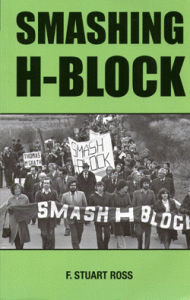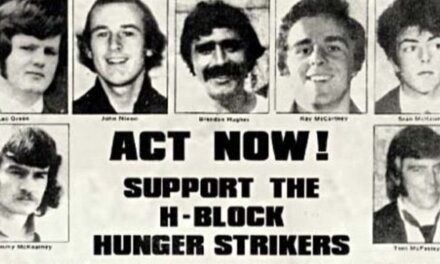Dozens of books have been written about the political fall-out from the 1981 H-Block hunger-strike and Margaret Thatcher’s criminalization policy that preceded it. Several have been written from the perspective of the prisoners and hunger-strikers themselves. A recently published book looks at the struggle on the outside in support of the prisoners and is reviewed here by veteran republican and ex-POW, Gerry O’Hare –
Until now, there’s been nothing to record the determination, the struggles, the agonizing decisions, the comradeship and the sheer hard work of the campaigners outside the jails.
That has now been put right in honorable fashion by F. Stuart Ross in a book for which republicans, future historians and other academics should be eternally grateful.
The so-far untold story of the men and women who fought the good fight, first against an uncaring world, and then in the glare of the world’s media, is both important for the future and fascinating in its own right.
Far, far outside the Blocks, people were gradually mobilised by various groups and the work led to thousands of street protests, not just in the 32-Counties, but in other countries all around the world.
Who were these groups? How did they come together in massive shows of support which seemed, on the face of it, to show it was possible to unite people in a way not seen before in Ireland? How did people from the left, centre and even the right – socialists, communists, the trade unions and even the business classes – find common cause that temporarily allowed them to forget their differences and ideals in order to support a single issue?
‘Smashing the H-Blocks’ by F. Stuart Ross endeavors to trace the campaign from its start to its unhappy end. Ross is a Derry-based activist and academic with a PhD from Queens University and has also studied at Syracuse University in the US and at the London School of Economics.
It would be impossible in this review to detail every group or individual who assisted the campaign and to be fair the author takes no sides between them, instead fairly giving an account of who they were and what they did. At the end of every chapter he has diligent footnotes to back every assertion – which is essential of course but which must have taken many hours of hard work.
One quibble, here: it would have made it easier if the notes had been at the bottom of every page to avoid having to flick back and forth. The notes are really essential to an understanding of who was saying what.
Ross’s book limits itself to a political history of the prisoners’ struggle against the British prison system from 1976 to 1982. The author does mention earlier hunger strikes led by Billy McKee in 1972 for political status and the first hunger strike in the blocks by Brendan ‘Darkie’ Hughes and six comrades.
It is the Bobby Sands-led hunger strike on which Ross centres this attempt to bring clarity, firstly on how the street campaigns were organised and then on the bringing of thousands of feet marching through hill and dale over Ireland. He tells us that unlike other accounts of this period he wants to focus on the popular movement outside the prisons, challenging republican orthodoxy and stressing the importance of broad-based, grassroots movements in effecting political and social change. He believes that what happened outside the prisons during the three years of protest led to the reshaping and revitalising of modern day republicanism.
Recently, there has been much controversy over whether or not a settlement was offered after Sands and three other hunger-strikers died. These arguments have been unedifying, to say the least, and do not do justice to the men’s heroism. The author leaves that issue to others.
But what did take place on the outside with demonstrations around the world has never been properly told or told in such detail. Trying to pinpoint the moment when someone decided that a broad front should be mobilised is not easy, bearing in mind the number of groups involved, for example, Peoples’ Democracy, Sinn Féin etc.
However, Ross tells us that a Bodenstown oration in 1977, given by Jimmy Drumm, a well-known and highly-respected republican leader from the 1940s onwards, might give us a clue.
Drumm said: “A successful war of liberation cannot be fought exclusively on the backs of the oppressed in the six counties, nor around the physical presence of the British Army”.
He went on to say, “Hatred and resentment of this army cannot sustain the war, and the isolation of socialist republicans around the armed struggle is dangerous and has produced the reformist notion that ‘Ulster’ is the issue, which can be somehow resolved without the mobilisation of the working-class in the 26 counties”.
This statement by Drumm was seized upon by many left-wing groups, as well as republicans – who were then bedding down for a long war.
But above all, he was now saying openly that it had to be acknowledged that the armed struggle could not succeed on its own – there was a crying need for politics. Prior to Drumm’s words, the Republican Movement was reluctant to work with other groups in any protests – but now, even before the hunger strike protests, it saw the need for a broad front.
This broad front came to fruition during the hunger strikes a few years later.
There is no doubt that, among the various committees, Sinn Féin always had the largest representation and it had no love, particularly for the SDLP.
Fr Piaras O Duill was the first elected chairman of the National H-Block/Armagh Committee and, from that moment on, the author takes us on a journey through the various permutations and forms the campaign took. All these groupings coincided with massive changes within the Republican Movement along the lines given earlier by Jimmy Drumm.
From here on, the author details how the committees were formed locally and their structures, the dominant role of Sinn Féin and how others reacted to their position. He informs us of the myriad of regional committees formed and the absolute need to have support from the South.
In his account of the contentious decision about ending the first hunger strike, the decision-maker being Darkie Hughes, he only states that he came under huge pressure because of the feared, imminent death of Sean McKenna. We already know why Bobby Sands activated the second hunger strike, its ghastly death toll and the demonstrations that took place worldwide.
As stated earlier, this book is a must. It’s a great read about a sad and tragic period. Stuart Ross is to be applauded for this worthy contribution to republican prison history.
Book available through Amazon, here.




